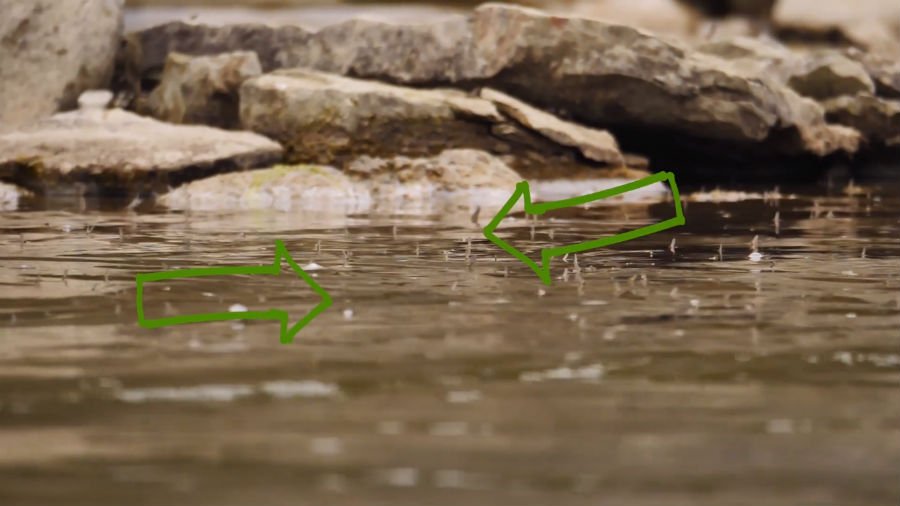How to Catch Trout in Eddies
Pools can be as small as a bathtub in streams, and as big as a small lake in large rivers. But they all share similar characteristics. The three prime fish-holding areas in pools are the head of the pool where water enters, the tail of the pool where water begins to speed up as it enters the pool exit, and the main current flows in the body of the pool.
Because pools can contain the widest variety of feed options, the techniques for fishing them are wide. The two major issues to be dealt with are placing the fly or lure at the right depth, and dealing with slower and often swirling currents.
Fishing pools - where water exits and enters
The places where water enters and exits a pool are called ‘heads’ (entry) and ‘tails’ (exits). These areas can be fished either by upstream or downstream methods.
Nymphing upstream in heads and tails
Use a fly-line or spinning with a bubble-float, cast up into the faster water and allow the fly to sink as it floats into the deeper water as the current slows, or at the tail cast into the slower water and allow the fly to drift in to the faster water. Allow the fly to lift on the end of the drift before picking it up for re-casting.
Depth control is important, and allowance must be made for the fact that depth will vary as the pool deepens (head) or shallows (tail). Too much weight and the fly will sink correctly in the faster water, but plummet to the bottom when the flow slows. If anything, err on the side of being too light, but be prepared to adjust the weight of the nymph or nymphs to get it right.
Line control can be tricky when fishing pools, because there can be slack water between the angler and the fly. More tricky still is back eddies between the angler and the fly. The only way of overcoming this is constant mending of the line, both up and downstream. You may well have to face the fact that on big rivers and big pools the volume of water, and the size of the eddies, may preclude fishing using upstream methods.
Fishing downstream in head and tail water
Use the traditional downstream method. Cast across the faster water and allow the fly to sink, then swing across the current and down into the pool. Retrieve with a twitching, irregular action.
Choose a line that will give you the best depth control. This can range from a floating line with a long leader, through slow sinkers and right down to fast sinking shooting-heads. The key to line choice is achieving the maximum lure action at the correct fishing depth. I find that wet flies with plenty of in-built action work best. Try Woolly Buggers, or any of the marabou flies. Big Glo-Bugs work well too - especially on a short leader, with a very fast sinking line.
Choice of lure when spin-fishing will again be governed by the weight required to achieve the best depth control. Lead-head jigs work well here. The soft-plastic tails provide good action with minimal action applied by the angler. If you carry a range of head sizes and weights, adjustments can be made quickly.
Fishing pools - the main body
The main body of the pool will usually contain the deepest water, with the slowest currents. And once again where your lure is, is the prime factor.
This water can be successfully fished using nymph, dry fly, downstream and spinning techniques. The key is to ensure that whatever fly or lure is being used, it is being fished at the correct depth.
Very often pools are formed where there is a distinct change in the direction of the stream or river, especially where the flow meets a steep bank or cliff. In this situation there may be quite strong, but narrow, currents running alongside the bank or cliff. These are prime fish-holding areas. Drifting a fly down through these fast current areas is often one of the most successful forms of trout fishing. But it can be the most difficult.
The currents pushing up against the cliff or bank push back-eddies out across the pool. So maintaining the fly in the main current without the line pulling the fly away is often a problem.
One way of overcoming this is to get into a position as directly below the main flow as possible and cast directly up-current. Anything you can do to reduce the angle will help. Another method is to hold the rod tip as high as possible to have the least amount of fly-line on the water as possible.
Most of the time we think of a river as having an upstream and downstream in terms of water direction. In other words, water flow is pretty much constant, in terms of direction. But this is not so.
Even when water is traveling apparently straight downstream in a river of uniform shaped banks, what is happening underwater might not be the same as what appears on the surface. Very often underwater features may alter the direction of the water, and therefore the direction a fish is facing.
In fact the way, or direction, a fish is facing can provide a clue as to where to cast in order to have the fly or lure pass in front of the trout's nose. If the trout is lying at an angle to the apparent current flow, then, if you were nymphing, the fly might best be cast to one side of directly upstream.

